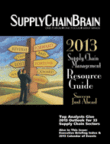
Visit Our Sponsors |
|
|
|
|
|
|
|
|
|
|
|
|
|
|
|
|
|
|
|
|
|
|
|
|
|
|
|
|
|
|
|
|
|
|
|
|
|
|
|
|
|
|
|
|
|
|
|
|
|
|
|
|
|
|
|
|
|
|
|

In today's tough economy, many corporations look for a magic bullet or quick solution to address all their business issues. With the fast pace of technological advancements, many organizations rely heavily on what technology can do for them. This approach, however, can lead to an automated yet erroneous and inefficient way of forecasting and planning demand. Good advice from experts is to keep in mind essential principles for increasing the likelihood of achieving success with your organization's demand planning and forecasting strategy:
* Demand Planning and Forecasting Is Ruled by the Business
It is the business and not the technology that drives the demand planning and forecasting strategy. Technology is the vehicle and, of course, it's always good to have the best possible technology in place. It is important, however, to define the process that will make more sense with a specific situation, then modify the technology to fit to your process"”not the other way around"”to enhance the likelihood for deploying the best possible solution.
* Data Is Precious Material
Everyday organizations grapple with the ever-increasing volume and complexity of data. Though it is becoming more difficult to derive value from diverse sources of data, the principle for extracting value remains the same: establishing a careful and well-defined process for collecting, cleaning and preparing data is essential for maintaining the validity, confidence and relevance of the data for planning and forecasting demand purposes.
* What Is Not Measured Cannot Be Controlled
Before starting to look to the future, it is important to measure and monitor the present. Putting the right key performance indicators in place and monitoring them regularly can greatly help in defining and configuring reliable planning strategies and improving the accuracy of forecasting scenarios.
* Forecasts Are Meant to Be Challenged
Forecasts are always relatively inaccurate. It is thus important to challenge them to elicit tactical changes and drive demand, use them to change the business, and find ways to improve them. Also important is to consider error margins and plan for having safety stock margins.
* Collaboration Has Always Been Key
Demand planning and forecasting has always been a collaborative and cross-functional process. Though it involves a rigid statistical methodology, collaboration from all stakeholders can help organizations obtain the right type of information regarding quality and quantity. For example, sensing demand from sales and operations can add value to an organization.
The game remains the same"”planning demand is about being efficient throughout the supply chain to meet customer demands. Technology plays a key role in providing the means to do it. But never before has maintaining the core principles been so important for keeping the right method in place to meet customer demands.
The Outlook
In 2013, while disruptive technologies"”e.g., mobility and big data, etc."”will continue entering the enterprise software space, the need for establishing best-of-breed methodologies to meet customer demands remains intact. It is important to keep focused on not only maintaining a consistent and well-established strategy for demand planning and forecasting but also incorporating agile mechanisms for adjusting to ever-changing conditions.
As Peter Drucker said: "The future requires decisions"”now. It imposes risk"”now. It requires action"”now."
Keywords: integrated business planning, demand planning, demand management, forecasting strategies, data mining, data management
RELATED CONTENT
RELATED VIDEOS
Timely, incisive articles delivered directly to your inbox.


